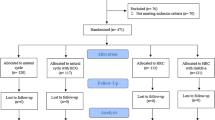Abstract
Purpose
The purpose of this study was to determine the effect of stimulated and artificial endometrial preparation protocols on reproductive outcomes in frozen embryo transfer (FET) cycles.
Methods
We performed a retrospective study of 1926 FET cycles over a 3.5-year period in the Fertility Unit at a University Hospital. Stimulated and artificial protocols were used for endometrial preparation. The embryos for FET were obtained from either in vitro fertilization or intracytoplasmic sperm injection cycles. Live birth rate and early pregnancy loss rates were retrospectively compared.
In artificial protocols, oral or vaginal administration of oestradiol 2 mg two or three times a day was followed by vaginal supplementation with progesterone 200 mg two or three times a day. In stimulated protocols, recombinant follicle-stimulating hormone was administered from day 4 onward. Vaginal ultrasound was used for endometrial and ovarian monitoring. A pregnancy test was performed 14 days after FET. If it was positive, oestradiol and progesterone were administered up until the 12th week of gestation in artificial cycles. We defined early pregnancy losses as biochemical pregnancies (preclinical losses) and miscarriages.
Results
Data on 865 artificial cycles (45% of the total) and 1061 stimulated cycles (55%) were collected. Early pregnancy loss rate was significantly lower for stimulated cycles (34.2%) than for artificial cycles (56.9%), and the live birth rate was significantly higher for stimulated cycles (59.7%) than for artificial cycles (29.1%).
Conclusion
In frozen embryo transfer, artificial cycles were associated with more early pregnancy loss and lower live birth rate than stimulated cycles.
Similar content being viewed by others
References
Dyer S, Chambers GM, De Mouzon J, Nygren KG, Zegers-Hochschild F, Mansour R, et al. International Committee for Monitoring Assisted Reproductive Technologies world report: assisted reproductive technology 2008, 2009 and 2010. Hum Reprod. 2016;31:1588–609.
Calhaz-Jorge C, de Geyter C, Kupka MS, de Mouzon J, Erb K, Mocanu E, et al. Assisted reproductive technology in Europe, 2012: results generated from European registers by ESHRE. European IVF-Monitoring Consortium (EIM) for the European Society of Human Reproduction and Embryology (ESHRE). Hum Reprod. 2016;31:1638–52.
Casper RF, Yanushpolsky EH. Optimal endometrial preparation for frozen embryo transfer cycles: window of implantation and progesterone support. Fertil Steril. 2016;105:867–72.
Groenewoud ER, Cohlen BJ, Al-Oraiby A, Brinkhuis EA, Broekmans FJ, de Bruin JP, et al. A randomized controlled, non-inferiority trial of modified natural versus artificial cycle for cryo-thawed embryo transfer. Hum Reprod. 2016;31:1483–92.
Jouan C, Emonard V, Ruggeri P, Debelle L, Hincourt N, Lorquet S, et al. Pregnancy outcome following frozen embryo transfer after artificial cycle or treatment by clomiphene citrate. Gynecol Endocrinol. 2016;29:1–4.
Tomás C, Alsbjerg B, Martikainen H, Humaidan P. Pregnancy loss after frozen-embryo transfer a comparison of three protocols. Fertil Steril. 2012;98:1165–9.
Ghobara T, Vandekerckhove P. Cycle regimens for frozen-thawed embryo transfer. Cochrane Database Syst Rev. 2008;Suppl 1:CD003414.
Groenewoud ER, Cantineau AE, Kollen BJ, Macklon NS, Cohlen BJ. What is the optimal means of preparing the endometrium in frozen-thawed embryo transfer cycles? A systematic review and meta-analysis. Hum Reprod Update. 2013;19:458–70.
Zegers-Hochschild F, Adamson GD, de Mouzon J, Ishihara O, Mansour R, Nygren K, et al. International Committee for Monitoring Assisted Reproductive Technology (ICMART) and the World Health Organization (WHO) revised glossary of ART terminology, 2009. Fertil Steril. 2009;92(Suppl 5):1520–4.
Lemery D, Legendre G, Huchon C, Perrier I, Deffieux X. Recommandations pour la pratique clinique:“pertes de grossesse”. Introduction, législation. Journal de Gynécologie Obstétrique et Biologie de la Reproduction. 2014;43:748–52.
Wright KP, Guibert J, Weitzen S, Davy C, Fauque P, Olivennes F. Artificial versus stimulated cycles for endometrial preparation prior to frozen-thawed embryo transfer. Repro Biomed Online. 2006;13:321–5.
Kollmann M, Martins WP, Lima ML, Craciunas L, Nastri CO, Richardson A, et al. Strategies to improve the outcomes of assisted reproduction in women with polycystic ovarian syndrome: a systematic review and meta-analysis. Ultrasound Obstet Gynecol. 2016;48(Suppl 6):709–18.
Kofinas JD, Blakemore J, McCulloh DH, Grifo J. Serum progesterone levels greater than 20 ng/dl on day of embryo transfer are associated with lower live birth and higher pregnancy loss rates. J Assist Reprod Genet. 2015;32:1395–9.
Ortega I, García Velasco JA. Progesterone supplementation in the frozen embryo transfer cycle. Curr Opin Obstet Gynecol. 2015;27:253–7.
Gingold JA, Lee JA, Rodriguez-Purata J, Whitehouse M, Sandler B, Grunfeld L, et al. Endometrial pattern but not endometrial thickness impacts implantation rates in Euploid embryo transfers. Fertil Steril. 2015;104:620–8.
Andersen CY, Fischer R, Giorgione V, Kelsey TW. Micro-dose hCG as luteal phase support without exogenous progesterone administration: mathematical modelling of the hCG concentration in circulation and initial clinical experience. J Assist Reprod Genet. 2016;33(Suppl 10):1311–8.
Cicinelli E, de Ziegler D, Bulletti C, Matteo MG, Schonauer LM, Galantino P. Direct transport of progesterone from vagina to uterus. Obstet Gynecol. 2000;95(Suppl 3):403–6.
Author information
Authors and Affiliations
Corresponding author
Ethics declarations
The study was approved by Institutional Review Board, and the study data completely excluded the identification of subjects.
Conflict of interest
The authors declare that they have no conflict of interest.
Rights and permissions
About this article
Cite this article
Hatoum, I., Bellon, L., Swierkowski, N. et al. Disparities in reproductive outcomes according to the endometrial preparation protocol in frozen embryo transfer. J Assist Reprod Genet 35, 425–429 (2018). https://doi.org/10.1007/s10815-017-1078-0
Received:
Accepted:
Published:
Issue Date:
DOI: https://doi.org/10.1007/s10815-017-1078-0




